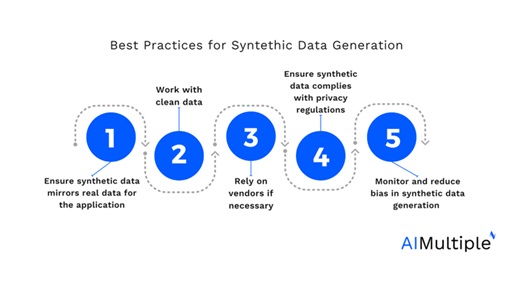Ensuring Data Privacy in Machine Learning: The Role of Synthetic Data in Protecting PII
In today’s data-driven world, machine learning (ML) models rely on vast amounts of information to power insights, automation, and decision-making. However, as organizations increasingly leverage these models, they must also address the critical challenge of protecting personally identifiable information (PII). Regulatory frameworks like GDPR, CCPA, and HIPAA place stringent requirements on how data is collected, processed, and shared, making privacy-preserving techniques essential for responsible AI and ML development.
One of the most promising solutions to this challenge is synthetic data. By replacing real-world PII with artificially generated yet statistically accurate datasets, organizations can maintain the analytical value of data while ensuring privacy compliance. This article explores the challenges of data privacy in machine learning and how synthetic data is emerging as a powerful tool for mitigating privacy risks across a variety of industries.
The Privacy Challenges in Machine Learning
Machine learning models require high-quality, diverse datasets to function effectively. Their predictive accuracy and generalizability hinge on the ability to detect patterns, make informed decisions, and adapt to real-world applications. However, these datasets often contain sensitive information, such as personal identifiers, financial records, and health data, posing significant privacy risks. Organizations must balance the need for large-scale data access with stringent privacy safeguards to protect sensitive information.
Some of the key privacy risks organizations face include:
- Exposure of Sensitive Information: Many datasets contain personal details that, if exposed, can lead to data breaches and compliance violations.
- Re-Identification Risks: Even anonymized datasets can sometimes be reconstructed, revealing identifiable information.
- Regulatory Compliance Barriers: Strict data privacy regulations limit how PII can be used and shared, restricting access to valuable datasets for ML training and testing.
As ML adoption grows, organizations must navigate the challenge of ensuring data remains both useful and private. While access to large, diverse datasets is crucial for accurate predictions and meaningful insights, concerns over security breaches, regulatory compliance, and ethical data usage continue to escalate. This growing tension underscores the need for innovative solutions that allow machine learning models to thrive without compromising sensitive information.
How Synthetic Data Protects PII
As organizations search for viable solutions to these privacy challenges, synthetic data emerges as a powerful alternative. Synthetic data is artificially generated yet statistically representative of real-world datasets while removing any direct connection to actual individuals. This approach significantly enhances privacy in ML applications in several ways:
- Eliminates Direct Exposure of PII: Since synthetic data is not derived from real users, it removes the risk of exposing sensitive information while maintaining data utility.
- Prevents Re-Identification Attacks: Unlike traditional anonymization techniques, synthetic data ensures that no individual in the dataset corresponds to a real person, making de-anonymization nearly impossible.
- Enables Regulatory Compliance: With no actual PII present, organizations can more easily meet data privacy requirements and expand access to data for AI/ML research and development.
- Improves Model Training and Fairness: By generating diverse and balanced datasets, synthetic data can mitigate biases in ML models and improve generalizability.
By eliminating the risks associated with real-world PII exposure, synthetic data enables companies to confidently develop AI applications that remain compliant with regulatory standards. This innovation ensures that privacy protection does not come at the expense of analytical depth or model performance.
Techniques for Generating High-Fidelity Synthetic Data
To ensure that synthetic data remains useful for machine learning while protecting privacy, organizations use several advanced techniques:
- Generative Adversarial Networks (GANs): These AI models generate synthetic data that closely resembles real-world datasets while preserving underlying statistical patterns.
- Differential Privacy Mechanisms: Adding noise to the dataset prevents reverse engineering of PII, further enhancing privacy protection.
- Variational Autoencoders (VAEs): These deep learning models create synthetic representations of datasets while maintaining key distributions and correlations.
- Rule-Based Data Synthesis: Industry-specific rules and constraints can generate realistic synthetic data tailored to fields such as finance or healthcare.
Real-World Applications of Synthetic Data in ML
Organizations across various sectors are turning to synthetic data as a reliable solution for safeguarding privacy while preserving analytical value. As industries grapple with stringent data protection regulations and rising concerns over security breaches, synthetic data offers a viable way to continue leveraging valuable insights without compromising sensitive information. Some industries where synthetic data is becoming increasingly important include:
- Healthcare: Synthetic patient records enable researchers to develop AI-driven diagnostics without violating HIPAA regulations.
- Finance: Banks and financial institutions use synthetic data to test fraud detection algorithms while ensuring compliance with financial privacy laws.
- Retail & E-commerce: Synthetic consumer behavior data helps businesses optimize marketing strategies while safeguarding customer identities.
- Autonomous Vehicles: AI models for self-driving cars rely on synthetic sensor data to train systems without needing real-world driving logs containing PII.
By generating data that retains the statistical integrity of real-world datasets, businesses can confidently advance AI-driven initiatives while ensuring compliance and ethical data practices.
Conclusion
As machine learning continues to drive innovation, organizations must find ways to balance data utility with privacy protection. Synthetic data presents a compelling solution, allowing businesses to train AI models on realistic, high-fidelity datasets without exposing sensitive PII. By integrating synthetic data techniques into their ML workflows, organizations can enhance privacy compliance, reduce security risks, and unlock the full potential of AI-driven insights.
With regulatory pressures increasing and data privacy concerns growing, synthetic data is poised to become an indispensable tool in the future of responsible AI development. For organizations looking to implement privacy-first machine learning solutions, now is the time to explore the benefits of synthetic data.

